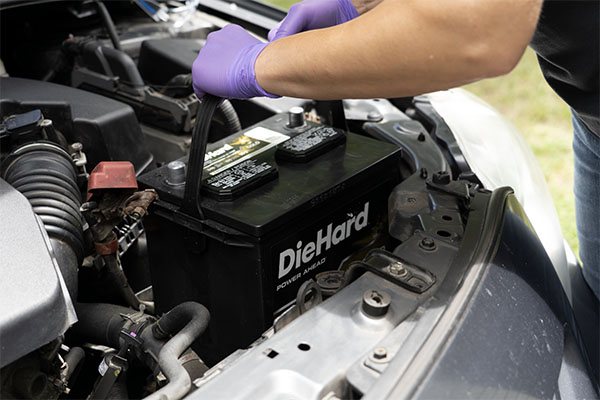Years ago, I had a '70 Impala hardtop with the 300-hp 350 V8. I'd tear around the Texas Hill Country in that Chevrolet until its heater core started to rot out and it'd lose coolant. Not a big deal, though —once that temperature gauge shot up, all I had to do was pull over, let the cast-iron block and heads cool down for about an hour, add coolant and I was back on the road.
Things don't work like that now, though. With aluminum engines, a timing belt and a bunch of sensors under the hood, a single overheating incident can be enough to result in a warped head, blown head gasket or other serious problems.
But there's one thing that hasn't changed over the decades. Even on new cars, the cooling system has a manageable number of parts: the radiator, hoses and hose clamps, thermostat, water pump, coolant temperature sensor and cooling fan. That's good news because it does narrow down the number of potential problems during a diagnosis, but there are a few other things to take into account if you're stuck by the side of the road with a pegged temperature gauge. Let's break it down.
Clogged Radiator
“Clogged" can mean a radiator that's obstructed externally or internally. If it's external, that usually means an accumulation of crud, leaves, bug carcasses and other debris in the radiator's cooling fins. If that's the case, you can easily (but carefully) remove the debris with a hose and a soft brush, being careful to not mangle the delicate cooling fins of the radiator. Vehicles that are equipped with AC will usually have the condenser in front of the radiator, but a buildup of leaves and bugs can still be enough to impede air flow around both units. If things are to a point where a hose can't get rid of all the junk, don't use a brush that's any stiffer than a toothbrush on those fins.
If the radiator is clogged internally, that's a different story. Coolant formulations include anti-corrosion agents that are designed to prevent a buildup of scale in the radiator's internal passages. Remember that the radiator is just one big heat sink that routes hot coolant through complex loops of tubes and cooling fins, multiplying the surface area for heat to dissipate to the outside air. The tubes are pretty small, and it doesn't take a lot of corrosion and scale to plug them to a point where coolant can't circulate well.
This kind of radiator failure is almost always a result of poor cooling system maintenance. Just like transmission fluid or motor oil, coolant has a service cycle and needs to be changed at a recommended interval. Otherwise, it breaks down and loses its ability to prevent boilovers or freezeups as well as losing its anti-corrosion properties. Your coolant should be bright green (or blue, purple, orange or whatever its original color was). Coolant that's looking brownish is definitely aged and degraded.
Pull the radiator cap and check the underside of the cap for a peanut butter-colored deposit; you can also use a hydrometer to check the specific gravity of the coolant. Shops use a refractometer for a more exact check on the coolant's condition.
In the old days, a radiator shop could "boil" or "rod-out" a severely clogged radiator. Today's radiators usually have a plastic shell, making that process obsolete. Instead, your best bet is to just be diligent about maintaining the cooling system by performing a routine radiator flush, dislodging any gunk and keeping your vehicle performing at 100%. When it's time for a flush and refill, you'll also need to pick up coolant, so be sure to get the right kind for your vehicle. When it's time to repair or replace your radiator, sensors, and fan clutches and radiators themselves from brands like Carquest Premium are built to last.

When the engine is cool, remove the cap to check coolant level and condition | Lisa Kowite
Low Coolant Level
This one's kind of a no-brainer... if there's not enough coolant in the system, you run the risk of overheating. Low coolant level would also mean a heater that doesn't work, by the way. Thing is, that coolant has to be going somewhere, either slowly or quickly, and there are multiple hoses, hose clamps and other failure points that can leak. A careful inspection of the cooling system should help you locate the leak.
Another potential source for a leak is the heater core. Located under the dash on the passenger's side, the heater core is designed like a half-size radiator. Hot coolant passes through it, and heat from the core is then diverted into a duct for the HVAC system, with a damper to control heat level. A leaking heater core will mean a wet floorboard and carpeting on that side, as well as a smell of coolant and possibly steam from the defrost and heater vents.
White smoke from the tailpipe can mean infiltration of coolant into the engine, which brings us to our next point....
Blown Head Gasket
A failed head gasket means that coolant is making its way into the engine's combustion chambers. Other signs of a head gasket problem can include motor oil that's past the full mark on the dipstick and has a peanut butter or milkshake appearance. In some instances, you might be able to detect bubbling in the coolant at idle, as combustion gases make their way back into the cooling system.
A blown head gasket is a real problem, but a minor leak can be remedied using a chemical approach. BlueDevil Head Gasket Sealer reacts to temperature differentials during circulation, identifying leak points in your cooling system and forming a chemical weld. It is 100 percent liquid and does not introduce any particulates into the system that could clog passages.

If the thermostat is open, the upper and lower hoses will be about the same temperature | Lisa Kowite
Thermostat
Your engine needs to get to operating temperature quickly, and the thermostat prevents coolant from going through the radiator until the engine warms up. At a predetermined temperature, the thermostat should open to allow flow through the entire system. A thermostat that's stuck shut would mean the engine will overheat fairly quickly, as coolant doesn't make it to the radiator to dissipate heat. Conversely, a stuck-open thermostat means that the engine might never reach operating temperature.
The thermostat is located at the inlet where the top radiator hose connects to the engine. One test is to take the thermostat out and put it in a pot of boiling water to see if it pops open. An easier method, though, is to just grasp the upper radiator hose (careful, it's going to be hot) and feel to see if it has coolant flowing through it or not.
Fuel Delivery
It might seem counterintuitive, but fuel metering problems can result in overheating. A lean-running condition can generate an excessive amount of heat in the combustion chambers, and in some instances a rich-running condition can as well. Lean conditions are rare in fuel-injected vehicles, but not unheard of, and a failing O2 sensor or MAF/MAP sensor can cause rich-running. If either one of these phenomena occurs, you're likely to see a check engine light and experience other drivability problems like poor performance, rough idle and poor fuel economy as well as overheating.

A visual inspection around the pulley can often confirm a leaking water pump | Lisa Kowite
Water Pump
The water pump is what pressurizes the coolant and allows it to flow through the radiator, heater core and engine cooling jackets. Water pumps are driven by a pulley and the serpentine belt, with blades and an impeller that force coolant along. The water pump has a finite life cycle, though, and it's not unusual for the pump to fail past 100,000 miles. Signs of a failing water pump can include:
- Clatter or rattle from galled bearings
- Coolant leak
- Loose water pump pulley and squealing or whining sound from the belt deflecting in the pulley
- Rust, deposits around water pump
- Rust in coolant
- Overheating
Engines that are equipped with a timing belt (rather than a chain) will need the belt changed at a factory-specified interval. Often, a service writer or tech will recommend changing the water pump at the same time, since the front end of the engine will already be partly disassembled. This recommendation is made based on a safe assumption that the water pump will fail at some point, and it will save you significant labor costs to have both jobs done at the same time. Regular cooling system maintenance can increase the life of the water pump by preventing build up of corrosion and deposits.

Modern radiator fans are electronically controlled | Lisa Kowite
Cooling Fan
The cooling fan behind the radiator used to be driven by a V-belt from the crankshaft and may have had a clutch that cycled it on and off. Today, every car is equipped with an electric cooling fan, with an integral shroud around it to concentrate and direct air flow. The electric fan cuts parasitic drag on the engine and cycles on and off according to input from a temperature sensor.
If the fan fails, it's likely to cause the fan's relay or controller to fail first. You might notice a burning-plastic smell as the fan motor slowly burns up, and of course the engine will overheat. Often a failing fan doesn't fail all at once, though—it may happen over a matter of days or weeks.
One last note: Like it says right there on the radiator cap, do not open the cap while the engine's still hot, otherwise you risk a geyser of overheated coolant going all over you. If your vehicle's engine is overheating, you can often draw the temperature down somewhat by turning the heater and heater fan on full-blast. Often it's enough to at least get you home!
Have you ever had to deal with an overheating car? Let us know how you fixed it in the comments.









